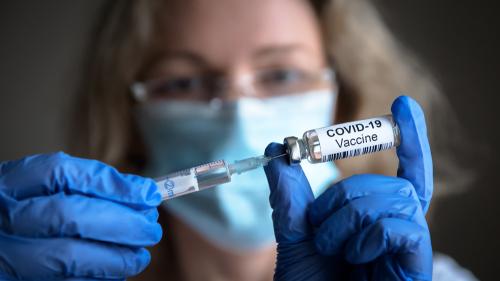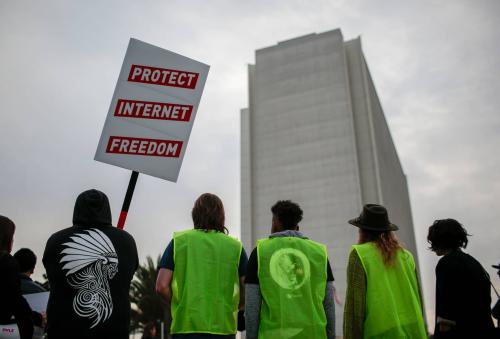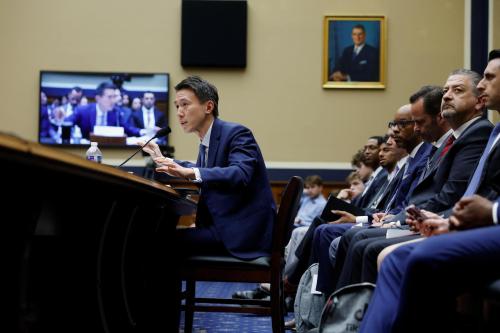Introduction
The U.S. Centers for Disease Control and Prevention (CDC)’s May 13 announcement that fully vaccinated individuals could resume pre-pandemic activities without wearing masks was met with praise from some, but confusion and condemnation from many public health experts. Although many celebrated the prospect of a return to normal life, others cautioned that relaxing mask recommendations when only 36% of the country was fully vaccinated was premature, and still others wondered how the new guidelines applied to their families. Without simultaneously requiring vaccine verification, the new guidelines gave the public the impression that they could dispel with mask wearing and social distancing.
There are steps the CDC and the Biden administration can take to mitigate the direct and indirect consequences of the new guidance. First, the Biden administration can help accelerate the rollout of vaccine verification nationwide. Second, the administration together with the CDC can support cities, states, and businesses that continue to require mask-wearing and other protective measures. Third, the CDC can issue additional guidance for workplaces and other settings, with specific consideration for the needs of vulnerable populations including families with young children and people who are immunocompromised. Finally, the White House should clarify the role of the CDC as a scientific institution that cannot be the sole decision-making entity in complex policy decisions.
Background
Since April 2020, the CDC has been consistent in advocating for widespread mask usage. The agency has generally erred on the side of caution, recommending mask usage even in low-risk environments such as outdoor settings.
This suddenly changed with the CDC’s announcement of updated guidelines on May 13, 2021, when the agency asserted that fully vaccinated individuals no longer needed to wear masks in public spaces and could safely resume virtually all pre-pandemic activities without personal protective measures. For months, public health experts and politicians had been calling for the CDC to update its mask guidance—including during a contentious hearing with CDC Director Rochelle Walensky two days prior—but the depth and immediacy of the change in the CDC’s position took much of the country, including public health experts, by surprise.
The result was widespread confusion. Without a concurrent requirement to present proof of vaccination, many interpreted the guidelines as removing mask requirements across the board. Within a day, 13 states had lifted mask mandates and accelerated reopening timelines. Major retailers and box stores such as CVS, Target, Costco, and Starbucks announced that they would no longer require masks. Pundits and politicians declared that the new guidance hailed the “end of the pandemic” despite only 36% of the population being fully vaccinated and a daily average of over 35,000 new cases and 700 deaths on May 13. Households across the country were unsure of how to interpret the new guidelines, especially families with children under the age of 12 who were not yet eligible for the vaccine and with members with severe immunocompromise who may not mount sufficient immune protection even after being inoculated.
What could the CDC have done better?
The science behind the CDC’s new guidelines is well-founded. The vaccines are all remarkably effective at both preventing contracting the virus and protecting against severe cases. In addition, they appear to work well against the major variants of concern in the U.S. and to substantially reduce the likelihood of spreading COVID-19. The evidence shows that fully vaccinated individuals can resume pre-pandemic activities with minimal risk to themselves or others. However, while their scientific basis may have been strong, the CDC faltered in the process, communications, and policy behind their announcement.
Process
The CDC made the decision to update its mask guidelines unilaterally, neglecting to inform and to involve relevant policymakers prior to the announcement. Due to their exclusion of vaccine verification requirements, the guidelines had the immediate effect of undermining mask mandates across the country. Yet state and local officials were not notified of the change before it was announced, leaving many rushing to update or justify their mask policies. The new guidelines also surprised businesses, who then had to choose between immediately removing mask requirements or continuing them without clear support from CDC guidelines. In the days following the release of the new guidelines, most major retailers rescinded masking requirements for vaccinated employees and customers, meaning that public spaces were almost certain to contain a mix of unvaccinated and unmasked individuals.
The guidelines also undercut efforts by the Occupational Safety and Health Administration (OSHA) to implement protections for employees in workplaces across the country. Prior to the announcement, the White House had been in the final stages of approving emergency COVID-19 workplace safety rules from OSHA, which many expected to include a mask mandate. The release of the updated guidelines cast doubt on OSHA’s ability to include the blanket mask requirement for workplaces that had been sought by labor unions and worker safety advocates.
In addition, the CDC appeared not to have actively engaged with the White House and other federal agencies in the decision to update the guidelines. Given the numerous political, economic, and health consequences of the new guidelines that have affected virtually every government entity, the White House should have been highly involved in the decision to formulate and disseminate the new guidelines—one of the most consequential policy shifts related to COVID-19 of President Biden’s term to date. Instead, numerous reports indicate that the CDC notified senior White House officials in charge of the coronavirus response of the change less than 24 hours before the release of the new guidelines. Had the White House directed an interagency response, the policy implications could have been understood and changes incorporated into the guidance before they were released. Instead, senior officials across federal, state, and local entities are left scrambling, trying to mitigate the worst impacts of guidelines that were released prematurely and unnecessarily hastily.
Communication
During the announcement and release of the guidelines, it was unclear that the effect of the guidelines would only apply to fully vaccinated individuals. Although the CDC did say that the change affected those who were vaccinated, without vaccine verification there was no practical way of distinguishing the vaccinated from the unvaccinated. Instead of being understood as a change in guidance for the vaccinated, the CDC guidelines were widely interpreted as a change in mask guidance—essentially, that mask mandates no longer needed to be in place, regardless of vaccination status. Indeed, the CDC did not provide suggestions for addressing the certainty that unvaccinated people would stop wearing masks.
There was a key intermediate step that could have been instituted. One was to say that vaccinated people could safely be around other vaccinated individuals, without masks or distancing. If this were included in the guidance, it could have given businesses and local and state policymakers leeway to adjust regulations in favor of vaccine verification. The CDC could have said that if vaccine verification is not done, masks should still have to remain in place in indoor settings. However, this crucial step was neglected, and masking requirements went by the wayside.
Beyond this critical omission, the guidelines were incomplete in other ways. They did not include any recommendations for households with children under the age of 12 (who are not yet eligible for the vaccine) or immunocompromised members (for whom the vaccine may not offer optimal protection). As mentioned above, they also omitted recommendations for places in which vaccinated and unvaccinated people are interspersed, such as in workplaces, businesses, and other public spaces.
Policy
The CDC’s major shortcoming was that it acted like a medical professional advising an individual patient instead of a public health institution providing guidance for the nation. Since the vaccines are so effective, it would be appropriate for a doctor to tell a vaccinated patient that they no longer needed to wear a mask. However, public health policy should incorporate community and societal considerations beyond individual medical concerns. By not acknowledging the need for proof of vaccination, the CDC caused the repeal of mask mandates for vaccinated individuals without providing jurisdictions with a mechanism to enforce restrictions for the unvaccinated.
Instead, the CDC should have anticipated that their guidelines would be understood as having broad national ramifications. They should have provided additional guidance for interpreting and applying the new guidelines in states and localities. With only 36% of the population fully vaccinated at the time of the announcement, it was not yet time for the community at large to abandon personal protective measures. A well-thought out policy would have acknowledged the need for individuals to show proof of vaccination in order to relax protective measures. For instance, EU member states have begun requiring “digital green certificates” of vaccination status for travel within the bloc, and some music and sports venues have begun requiring proof of vaccination when hosting events with higher capacity limits. New York state has successfully implemented the Excelsior pass that indicates either vaccination or recent negative test. Such a policy also would have contemplated target community vaccination rates—say, 70 percent of the adult population with at least one dose—that cities and states should achieve before lifting universal mask requirements.
Policy recommendations
The CDC and the rest of the Biden administration must take action to counteract any negative effects of the new guidelines. We recommend the following four steps:
1. Support vaccine verification
The Biden administration has been reluctant to support any form of vaccine verification. Unlike other countries such as Israel, whose Green Pass for entry into restaurants, venues, and most other public spaces has been widely credited with effecting the country’s high vaccination rates, the U.S. has not implemented any nationally-approved vaccine credentialing system. Instead, President Biden has stated that the federal government does not have a role in a national vaccine credentialling, and instead will leave vaccine verification to the private sector.
We agree that a federal vaccine credential would be difficult to implement in the United States politically, and argue against using the term “passport” because it is a partisan lightening rod that unnecessarily inflames the conversation. Indeed, “passport” is an inaccurate description of what is essentially an extension of a health screen. However, President Biden can and should support vaccine verification. First, he should actively support businesses and venues that require proof of vaccination from customers or employees. Like the COVID exposure and symptom screening that many businesses have employed over the past year, vaccination screening will grant peace of mind to business owners and customers and hinder the spread of the virus among the unvaccinated.
Second, the administration should provide greater support for the development of vaccine verification tools in the private sector. The administration has been working with technology and health companies to develop standards for acceptable proof of vaccination, which private companies can then use to create their own vaccine passports. Some states have already rolled out these tools. New York launched its Excelsior Pass in April, which residents can use to access performances, sporting events, and other large gatherings, and Hawaii is slowly rolling out a similar mechanism (other states, however, have banned such vaccine credentialing). Without federal guidance, verification tools are at risk of becoming a disorganized, unregulated patchwork of standards. Yet progress on verification standards has been slow; as of the publication of this article, it has been over two months since the administration announced they were working on these standards, with no updates on their status. The Biden administration should release these standards as soon as possible to allow private vaccine verification tools to be developed and adopted across the country.
2. Support cities, states, and businesses that have maintained a more cautious approach to reopening
Despite pressure to lift mask mandates in light of the new guidelines, some have chosen to keep masks in place until vaccination rates improve. At the state level, Oregon governor Kate Brown announced that she would not reopen the state until at least 70% of residents over the age of 16 have received their first vaccine dose. In the meantime, the state allowed businesses to carve out “vaccinated sections” with no distancing requirements or capacity limits. Businesses must verify vaccination status to operate these sections, and if customers wish to remove their mask, they need to present proof of vaccination. In Pennsylvania, Governor Tom Wolf said that the state will continue to mandate masks in most settings for both vaccinated and unvaccinated people until 70 percent of the state’s adult population has been fully vaccinated.
At the local level, cities such as Baltimore have kept mask mandates in place even as statewide mandates have been lifted. Baltimore Mayor Brandon Scott stated that it will leave the mandate in place until 65 percent of its residents over 16 have received their first dose. In addition, some businesses, such as Albertsons and Apple, as well as many small businesses, are also still requiring customers and employees to wear masks.
The CDC and Biden administration should support these public and private efforts as an example of proper interpretation of the guidelines. Though masks can be a choice for fully vaccinated people, mask mandates are still needed in the absence of robust vaccine verification protocols to inhibit spread among the unvaccinated, especially in essential businesses that families with young children and those immunocompromised cannot choose to avoid. Encouraging continued mask mandates will clarify that, while vaccinated individuals no longer need to take precautionary measures, states still need policies in place to protect the unvaccinated in places where unvaccinated and vaccinated intermingle.
The Biden administration should differentiate between essential and nonessential businesses and should especially encourage the former to maintain masking requirements. Grocery stores, pharmacies, and other essential businesses still need indoor masking in order to protect children, immunocompromised individuals, and employees and patrons who are not yet vaccinated or who have at-risk family members themselves.
3. Issue guidance for workplaces and other settings
As a follow-up to the guidelines for fully vaccinated people, the CDC should issue clarifying guidance for workplaces, public spaces, and households where vaccinated and unvaccinated people mix. Many vaccinated people live with others who cannot enjoy vaccine protection, such as the immunocompromised or young children. Although the vaccines have been shown to reduce the circulation of the virus, it is still uncertain if vaccinated people in these households can safely resume pre-pandemic activities without putting their family members at risk.
The CDC should also coordinate with OSHA to release updated guidance for workplaces and employers. Prior to the CDC’s announcement, the White House had been close to finalizing new emergency COVID-19 workplace safety regulations recommended by OSHA. Many expected the regulations to include a mask mandate for all employees, as well as a requirement for employers to conduct a COVID-19 hazard assessment. In response to the new guidelines, OSHA instructed employers to follow the CDC’s new mask guidelines, signaling that a universal mask mandate would likely not be included in the final set of regulations. However, OSHA’s regulations may still require unvaccinated employees to undertake precautions such as wearing masks and maintaining social distancing.
The CDC and OSHA will need to issue two sets of guidelines for employers who require or forego proof of vaccination, respectively. If workplaces can guarantee that all employees are vaccinated, presumably it would be safe for employees to interact without masks or distancing. If this cannot be done, though, would everyone need to keep masks or distancing, or only those who are unvaccinated? Will special protocols need to be put into place—for example, conferences rooms should have not unvaccinated individuals sitting in close proximity with one another, maskless? What kind of proof of vaccination would be acceptable? In addition, the CDC should advise on what can be done in place of vaccination—for instance, workplaces can use twice-weekly surveillance testing to replace proof of vaccination.
4. Clarify the role of the CDC
The CDC is a scientific institution. Its chief role is to interpret research and formulate evidence-based guidance. However, the authority ceded to the agency by the Biden administration has enabled it to make policy decisions that some would say is beyond its sole jurisdiction, as exemplified by the updated mask guidelines. The administration should make clear that the CDC is a scientific organization. Policy decisions that involve many different entities should be coordinated through the White House, or, at the very least, through a collaborative, interagency effort.
In addition, the administration should emphasize that public health is about not only science, but also values. Among the many lessons COVID-19 has taught us, it’s that those most vulnerable and who already bear the greatest brunt of disparities will suffer even more unless we as a society prioritize their protection. The CDC’s latest guidance has made it less safe for some of the most vulnerable among us and such a decision has the potential to worsen existing inequities.
Conclusion
The CDC’s guidance has signaled the end of the pandemic for many in the U.S., but this is a premature declaration of victory. Those unvaccinated are still at risk for contracting and dying from COVID-19, and with most restrictions removed around the country, the window of opportunity to tie reopening policy to vaccination has closed. The CDC and the Biden administration should act immediately to mitigate the risks resulting from the new mask guidelines. The vaccinated may be well-protected from the virus, but we cannot overlook our obligation to protect those who do not yet have immunity or waver in our commitment to end this pandemic once and for all.







